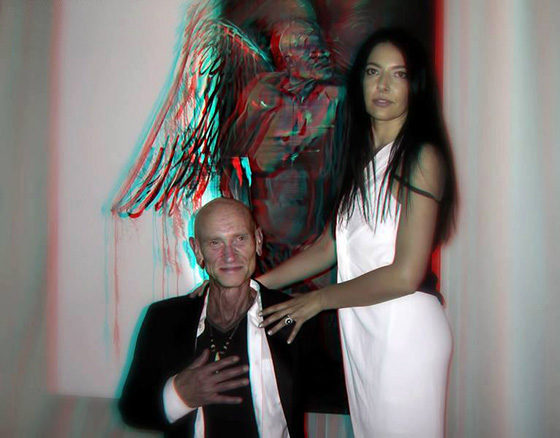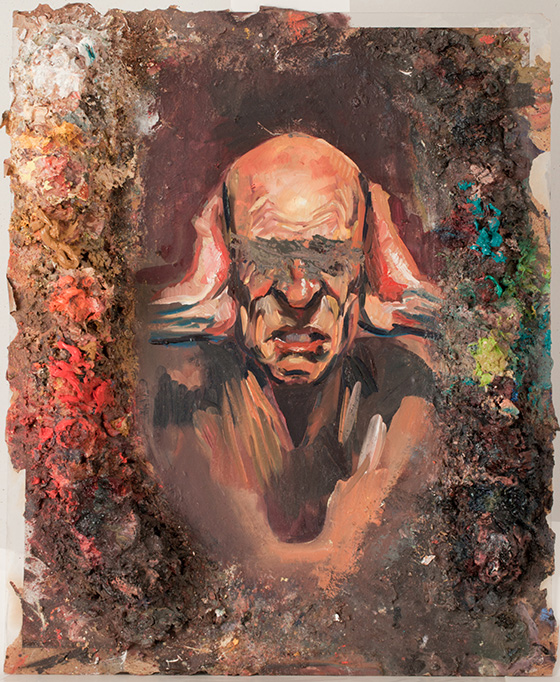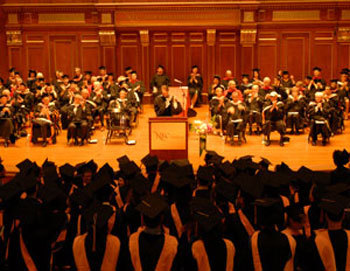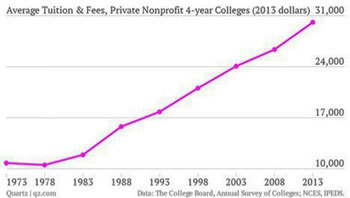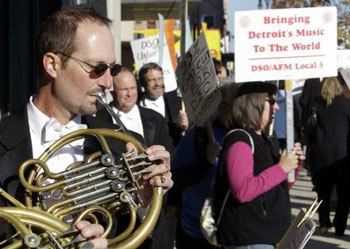![mark and z 560]() Image: Artist's Model Mark Snyder and Artist Zhenya Gershman, Franklin Londin 3-d Photography
Image: Artist's Model Mark Snyder and Artist Zhenya Gershman, Franklin Londin 3-d Photography
On Friday May 15th, a historic event took place at the Los Angeles LGBT Center, recognizing renowned artist's model Mark Snyder with a Lifetime Achievement Award - a first in its kind. Mark Snyder delivered a moving speech on behalf of all models who never had a chance to express the importance of their profession. "The Model's Artist," a complementary exhibition currently on view at Los Angeles LGBT Lily Tomlin/Jane Wagner Cultural Arts Center through June 13th, reveals a unique 14-year collaboration between artist Zhenya Gershman and model Mark Snyder. This event was produced in collaboration with project AWE, a non-profit organization on a mission to support and explore the arts. Here are the profound words of Mark Snyder:
"The Model speaks; what a concept! I've always dug the fact that we models face the challenge of communicating non-verbally, so actually using words presents its own challenge, one I hope I'm up to.
We are all multidimensional beings of limitless potential. The people with whom I've had the pleasure of conspiring to invent this night are no exceptions. All have taken on roles showcasing the unique and diversified gifts that necessarily must come into play to manifest a vision like the one surrounding you tonight. All have poured their hearts into this effort in hopes that it will help elevate the inner conversation in those who experience it.
I see a contingent of LA's top models here tonight, and I truly appreciate your presence. This night's for you, too! I'd also like to pay homage to our artist-teacher collaborators. We are co-dependents in the best sense of the word. That bond of mutual need fuels and fires the teacher-model-student trinity. On behalf of us models, I thank you for the care and concern you lavish on us, always making sure we know we are golden to you.
We are also greatly blessed tonight with the presence of an LA modeling legend - Nancy Lily. A key figure in figure history, she is known and cherished by us all. Following years active in modeling, she moved on to be the model coordinator at Art Center College. She held benevolent court there for decades. She had the power to supercharge the career of any fledgling model she sensed worthy. I know, because it happened to me. Nancy, we welcome you; we honor you for everything you've done for us, and everything you are to us. You are the godmother of us all, and we just thank you.
It's only proper to start by invoking the man responsible for bringing us all together tonight. That's the spirit of the model's patron saint, the international
cause celebre and local legend, Antonio Corsi. In the early 20th century, Corsi was like a one-man "golden age of models," a star of his times. He embodied the "renaissance man," collaborating with artist greats in the creation of timeless art both here and across Europe. He even dipped his toes in that Hollywood upstart, "moving pictures." After his untimely passing in 1924 at age 55, in the town of Garvanza, now a neighborhood of Los Angeles, it seems a sort of model dark ages set in. Models became the poor stepchild of the fine arts hierarchy, overlooked, underpaid, unheralded by society at large.
Now, however, all that's beginning to change. Folks are waking up to the cultural significance of the role we play, that we've always played, as evidenced by your presence here tonight, and the recent rise in model themes in books and on film. Almost a century after his passing, Corsi is back. The power of his narrative attracted a circle of art lovers and historians to set the record straight, do justice to his legacy.
"The Model's Artist" is a direct result of that joining of forces, as is the upcoming feature documentary,
"Corsi, Prince of Models."
My admiration for the timely vision of film maker, Jake Gorst, Tracey Gorst, and producers Charles and Tina Miller, knows no bounds. This whole project is a bonafide labor of love, and Zhenya and I are delighted to be caught up in your gorgeous "moving pictures." I think they're actually called "talkies" now.
These days, when someone says "model," what usually springs to mind is commercial models. Not surprising, since the print and electronic media assure these images get seen by millions daily.
When you think of it, however, artist's models are the REAL models, the "OG" models. We are the ones whose lineage stretches back hundreds of years. Our work, by nature, appreciates over time, not relegated to hamster cages or upstaged by the next big ad campaign. Rather than re-enforce stereotypes, we exist as models of diversity; our ranks celebrate the
Homo sapiens in all its glorious, infinite permutations. Nowhere is sheer egalitarianism is more evident than within our subculture. We are the standard bearers, we are the silent witnesses to the truth of body as sacred space. Our very existence quietly counters the prevailing mindset of body as profane: stupid, crude, and sin-laden.
Visibility-wise, we work "behind the scenes" and mostly out of view. We're found behind gates, guards and "Do Not Enter" signs. People pay for the privilege. Our images, far from mass-produced and consumed, are rather handcrafted, one at a time.
The attention we do get is hard won, the result of years and years of showing up, performing live to small groups, over and over, and over again. In LA, we drive ridiculous thousands of miles a year to make our gigs. All that's out of our pockets, too, but that's the givens, and we accept that. We are sustained by the spontaneous applause and the respect we see in our artist's and student's eyes. These shows of appreciation assure us that our contribution still counts, that our best efforts are far from in vain. Definitely worth the trip.
Subsistence-level income does not prevent models from living rich. Money has its place. However, to paraphrase Lao Tzu, "Once we feel we have enough, then we are rich." Counter-types, we find other ways to thrive apart from merely acquiring consumer power. For us, it's wealth in feeling, the richness found in unique, empowering, enlightening experiences. It's in the knowing that, with every pose, every gesture, we stand as living representatives of all mankind--past, present, and to come. It's being free, open and ready for the unexpected, the extraordinary to appear at any time. And it does. Ours is also the priceless wealth of owning our lives, being the ones to call our own shots.
There's richness in opportunities to collaborate with teachers of brilliance, depth and humanity. The Model's contributions are acknowledged and valued in the academic world. Together, we serve as inspiration for new generations of artists. Our stillness spawns action that swirls around us, expanding the breadth and scope of art in new directions. One could say we models are paid to meditate, to spontaneously create, to challenge our limits, to elevate the conversation wordlessly. Some even refer to us by the "M" word - "Muse!" We trigger the inner dialogue. We see the artist's darting, hungry eyes, ever grasping to commit something real, and honest, and true.
"Lifetime Achievement?" Pretty heady stuff, an honor humbling yet bewildering. It makes more sense seeing myself as a stand-in for all art models, selflessly sharing their essence in studios and classrooms near and far. It also signals the emerging awareness of the significance of our historical contribution to art and culture in general. At sixteen years in, I think myself just getting my model steam up, earning my chops, the late blooming boomer. I'm sure my siblings here, Brother Steve and Sister Mary K, would agree that my greatest achievement really comes down to, "I'm still (expletive) alive!"
I learned the hard way that visions and revelations of a freshly psychedelicized young mind had no welcome place in a society bound by war and acquisition. The draft, the war on drugs, the homophobic fever, all seemed tailor made to annihilate people of my ilk. The list of innocents succumbing to decades of this brutal, dominating mindset is long and tragic.
So what, in fact, are the achievements that led me here tonight? Most obviously, it's my years modeling in general, and my work with Zhenya specifically. But my story previous to that, I feel, is equally relevant, and telling.
I am not here because I played ball, or because I conformed. Seen through the lens of so-called traditional American values, the man before you stands as an unqualified, abysmal failure, a total loser with no perceived redeeming value. I sport no assets, no property, no spouse, no children. I've never owned a credit card, health insurance, or anything resembling disposable income. Rather, I have lived alone most of my adult life, figuring ways to balance the delicate dance pitting worldly responsibility and spiritual integrity, sensing myself every moment one stranger in a very strange land.
I came up in times when it was open season on Flower Children like me. Attacked by priests, betrayed by peers, jailed by cops, threatened by warmongers; what's a hippie love-and-peacenik to do to survive but go underground, guising in a life no one else would want, or feel threatened by? So, in the broader sense, this, too, is a crucial achievement in a life laid bare for you tonight. In a society plagued by body shame and degradation, artful nudity offered the perfect fit for my subversive deviance. Here, the body's elegant truth, laid bare, could counter the prevailing dirty lies. But that's another movie.
I am a product of the co-mingling of DNAʼs from Northern and Southern Europe via The Smoothing Iron Ranch in Eastern Washington and Potlatch, Idaho. My beloved parents, Joe and Bernie Snyder, met at a freshman "mixer" at the University Of Idaho, and, boy, did they mix! A World War and ten kids later, the 60ʼs hit. ʻNuff said. We boomers defined, and refined, the meaning of "generation gap." The Snyders survived, however, and thrived; looking back, our house-full reflected a microcosm of our turbulent times. All the stories were there, a panoply of American diversity complete with its soaring ups and crashing downs.
I carry my parent's legacy in a special way. That country DNA that found its way to LA blessed me with my Father's big, gnarly hands, my Mother's swooping arches, and all the other features that help me pay the rent and continue to live in dignity. So - Thanks, Mom and Dad!
My adventures in modeling was never a goal unto itself. For me, it's part of a larger journey dominating my life. Over time, with little else to call mine, I came to see the value of one thing I did have at my disposal - my own precious body. I came to see a universe within, the next frontier, worlds awaiting discovery. And, it was fully portable!
Never one for the well-worn path, in the body I found my own way of radical subversion, of needed inner healing. I channeled the love and care supposedly reserved only for others to my own body. (Gasp!) I hoped that, over time, I'd find ways to coax out secrets I, and others, could use to enhance life with powerful therapeutic tools for prevention, maintenance, and natural healing. Call it Practical Love.
Love is, after all, the Force that creates and sustains the All that Is. The wimpy moon-june-spoon contrivance is so over. The Love I'm talking about takes names and kicks (expletive); holistically, of course!
I've spent years alone, thousands of solitary hours forming this concept of exercise as active meditation, one that balances, strengthens and energizes the whole system, inside and out. It's about harnessing primal forces to forge the form as a sculptor would with wood and clay. So when you see my rendered image, what you are actually seeing is a work of art of a work of art.
Outwardly, the practice takes the form of weightless, yoga inspired movements in warm water. Inwardly, the process unites the upper and lower brains, the masculine "thinking" brain and the feminine "feeling" brain, the seat of intuition. The loss of this inner connection is at the root of human suffering, and Practical Love serves the purpose of this reunion of opposites. Homeostatic Integrity is the new game in town. Corporate fitness had its day, but lost its way. In the future, anybody will be able to begin a self-ministry, and witness the laws of physics refining us into the bodies we'll need to face the future.
What, one may ask, does any of this have to do with modeling? In my mind, the chances of introducing a daily practice able to successfully challenge the "fitness" model was as improbable as a middle-aged man coming into demand for his physique in body-centric LA. The modeling became a way for me to put my proto-body experiments to work "in the field," as it were, anonymously. No one knew what I've really been up to, what was driving my passion; what mattered was that I left everyone happy.
Modeling gave me the objective experience needed to see that I was, in fact, beating the odds, excelling in a tough, tight art-world subculture. Sixteen years and a few thousand gigs later, recently an official senior citizen, here I am, coming out to you, revealing my hidden side. I'm 65 going on 30, living in a bachelor pad, dancing my ass off at the drop of a pounding rhythm, and still expecting Mr. Dreamboat to sail up my harbor any day.
That's a relief! Thank you all for bearing with me; please enjoy the rest of this fabulous night compliments of the hard work and vision of the show's curator, Katie Poltz, my new friend, Norm, and the staff of the LA LGBT Center. Thank you, brother Evan Hatfield, for your magic sitar, thank you, Sean, on guitar, and you, my dearest Alma Cielo, who, acting on your own intuition, opened the door that led directly to this night.
Zhenya - words fall short to express the power of the bond we share. Choosing me as your partner in art has changed my life, giving space, validation and vindication to my wildest fantasies. You are incomparable, and, with your grace, I get to have a little taste of that, too."
![Zhenya Gershman]() Image: Zhenya Gershman, Silencio, oil on plastic palette
Image: Zhenya Gershman, Silencio, oil on plastic palette -- This feed and its contents are the property of The Huffington Post, and use is subject to our terms. It may be used for personal consumption, but may not be distributed on a website.






































